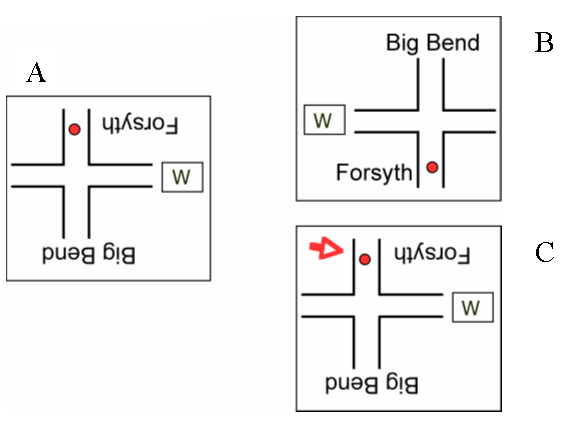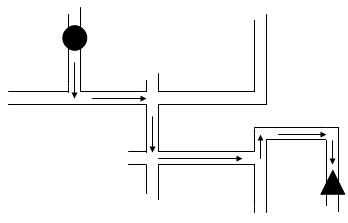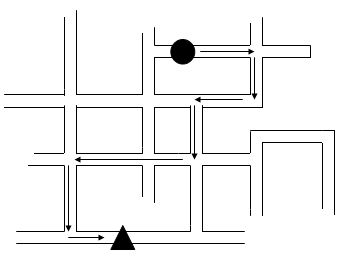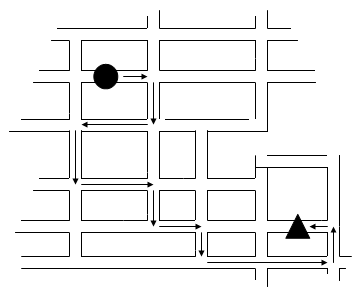Can you use mental self rotation to read a map?
What is mental self rotation? It is the ability to imagine yourself in different locations in space and imagine your body moving in space. This is an ability that is used in different everyday activities such as navigating in an environment or reading a map.
- Ability involved: egocentric spatial transformations (yes, that is the scientific expression) or mental self rotation.
- Brain areas involved: mostly parietal lobes.
Let’s take an example. Imagine that you plan to go to a new Walgreens location. You wonder whether going North on Big Bend Avenue you would have to make a right or a left turn onto Forsyth Blvd to get to Walgreens. You then look at the map that your spouse has laid out on the table. It turns out that the map is upside down so your perspective is not aligned with the one shown on the map (see Figure 1 just below, Box A). How do you get the answer to your question?

— Figure 1. The map is upside down (A). The red dot represents your car’s position. Your goal is to go to Walgreens (W). You can either perform an object rotation (B), that is imagine the map rotating, or a self rotation ©, that is imagine yourself at the red dot location.
To align your perspective with the one showed on the map you could imagine the map rotating until it is upright. This is shown at the top right corner of Figure 1 above (Box B). This is what psychologists call mental rotation of object. Another solution is to imagine viewing the map from the other side of the table. This is shown at the bottom right corner of Figure 1 above (Box C). Once you have imagined yourself on the other side of the table you can use your body coordinates and determine that you will have to take a left on Forsyth. In that case, the map is not moving but you are moving. This is what psychologists call mental self rotation.
Ready to imagine yourself moving in space?
For each map below count how many left and right turns you have to make to go from the circle to the triangle. Follow the arrows. Do not move your body or your hands, try to do everything mentally.



Solutions
Map 1: 3 left runs and 3 right turns
Map 2: 3 left runs and 3 right turns
Map 3: 6 left runs and 4 right turns
 — This article was written by Pascale Michelon, Ph. D., for SharpBrains.com. Dr. Michelon, Copyright 2008. Dr. Michelon has a Ph.D. in Cognitive Psychology and has worked as a Research Scientist at Washington University in Saint Louis, in the Psychology Department. She conducted several research projects to understand how the brain makes use of visual information and memorizes facts.
— This article was written by Pascale Michelon, Ph. D., for SharpBrains.com. Dr. Michelon, Copyright 2008. Dr. Michelon has a Ph.D. in Cognitive Psychology and has worked as a Research Scientist at Washington University in Saint Louis, in the Psychology Department. She conducted several research projects to understand how the brain makes use of visual information and memorizes facts.
More brain teaser games:



What is mental self rotation? It is the ability to imagine yourself in different locations in space and imagine your body moving in space.
In the Third Diagram Isnt it 7 left???
I keep finding 7 lefts in diagram 3.
There are only 6 left turns in diagram 3, as the solution states. You can print the map and do it (and let me know if I am wrong…)
Tried #3 one more time. Yup, I was wrong. Funny how you can’t see something then all of a sudden it’s clear. There are 6 lefts in diagram 3.
Glad to hear. But also funny how the previous comment by “ninja spy” may have anchored/ biased your perception towards the number 7…
I have done this my entire life and thought that it was something everyone did- does anyone out there ever ‘fly,’ so to speak above a map to gain locations and directions? Sounds weird but that is the best way to describe how I manage directions.
As a US Marine I was an artillery forward observer. That meant reading maps, locating targets and adjusting the impact location where the shells fell. Later, to pay for college, I worked as a pilot flying all over the country. Both of these jobs required the turning of maps around in the mind. It never occurred to me that to do so was anything special.
Thank you for those comments. Indeed it is a cognitive ability to do mental self rotations. For people who have been exercising that skill all their lives (and therefore become better at it) it looks like second nature now. But it is not one everyone has: the most clear example I can think of: years ago, while traveling in Africa, I tried explaining some adults there what a map is and how to use it to move more efficiently around town. The concept sounded like science fiction to them for a while, until, with rehearsal and practice, they came to understand how to use the map.
This is not genetics-it is (formal and informal) education and practice.
try orienteering. There are big clubs in Washington and St. Louis also.